What the Heck is a 6/4 Tuba?
This question comes up so often on various forums that I thought I'd devote a collection of photos of various tubas so that folks could visualize the differences.
And lots of folks ask about specific tubas, and being able to compare them with known horns will help them in ways the unscaled manufacturer's images can't.
So, let's start with the sub-title first. What is a 6/4 tuba? Before World War II, American tuba players in bands often used a sousaphone, partly because of its portability, and partly because of its sound. More about that "American" sound you can find in the discussions linked above, but suffice to say that it resulted from the sheer size of the large sousaphone then popular. Of course, no tuba player in an orchestra could use a sousaphone, not even a rain-catcher model with the bell pointed up. But the sousaphone sense of bottomless, enveloping sound influenced many players and orchestra leaders who wanted those organ-like qualities in their ensembles, and they demanded a line of very large instruments from the American manufacturers. York, Conn, King, Martin, Beuscher, and others obliged with a series of very large Eb basses loosely called Monster tubas, and also with even larger Monster BBb and CC tubas that we now call 6/4 instruments, or Big-Ass Tubas (BAT, for short).
In Europe, tubas were made in proportional dimensions, such that bell diameter and body size (and bore) were held approximately in scale with each other. Many German makers adopted a system of quarters to describe the general size of the instrument. A standard tuba was considered a 4/4 instrument. It typically had a bore of about 19mm, and a bell diameter of about 17 inches or a bit less. The Miraphone 186 described elsewhere at this site is a 4/4 instrument of that type. Rudolf Meinl makes a whole series of instruments following this naming convention. Their larger instrument is a 5/4, with a 20" bell and a large bore, and they even list a 6/4 instrument with a 22" bell and a huge bore. Look down the page to see a 5/4 Rudy, nearly as big as a 6/4 anything else.
Hirsbrunner was the first European maker to specifically copy that most famous of BAT's, the York made in the early 1930's that was owned by Arnold Jacobs and is now owned by the Chicago Symphony. Other similar instruments from that era included the Conn 36J Orchestra Grand Bass, and various huge Holtons and Martins. (Holton's explicit copy of the York didn't come until the 50's, and Martin always stuck to their own design as did Conn). When Hirsbrunner offered their York copy, nicknamed the Yorkbrunner (and later the HB-50 Grand Orchestral), they apparently wanted a way to describe the instrument's large size that would not be possible with just a picture. They used the term 6/4 in their description, in line with European convention. But unlike the Rudolf Meinl series, these horns are not proportional in bell size, body size, and bore. The bells are large, the bodies huge, but the bores typical of 4/4 rotary tubas. So the body size is probably the most accurate way to think of these designations.
But there is no standard for these terms, so they mean nothing that can be objectively measured. Consequently, some comparison photos will help people understand what the terms mean. The terms don't define the instruments, the instruments define the terms, and that is the motivation for this article.
While visited Dillon Music recently, I asked if I could take some pictures of the tubas they had in comparison with my own York Master. The York Master is what I have measured and called a 4/4 tuba, but after this comparison I'm revising that determination and calling it a 5/4 tuba. You will see why in the photos below. My thanks to Matt Walters at Dillon Music for tolerating my careful moving of instruments I cannot afford to take pictures of them.
(For photo buffs wandering in here from my camera pages, all the pictures in this article except for the first were taken with a Russian Fed 3 rangefinder 35mm camera and a Jupiter 12 35mm wide-angle lens. The first photo was made with a surprisingly excellent Canonet 28, dating from the early 1970's)
The first picture shows me playing a 6/4 York that was converted to CC by Bob Rusk and offered for sale by Dave Fedderly at Baltimore Brass. This is one of the most singing, easy-blowing tubas I have ever played, even though my brain does not at all work well with the CC notes and fingerings.
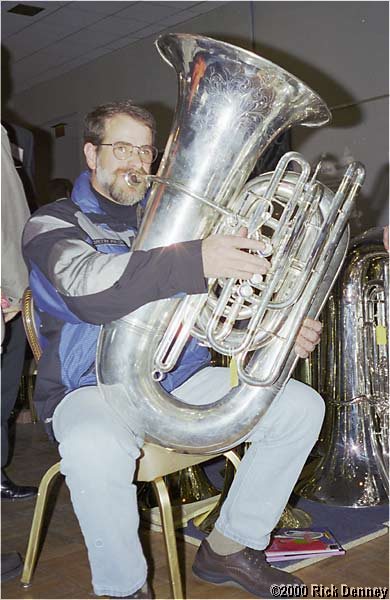
The Author playing a Rusk-converted York 6/4 tuba.
The following are the comparison photos that I made at Dillons, plus additional photos that have come my way in the years since that visit. A comparison instrument is in each photo, and that comparison instrument is also somewhere else on the page so that serial comparisons can be made. A ruler might have been better, but the comparison reveals differences in beefiness that are not that easy to characterize with just a few dimensions. The York Master is usually the comparison instrument, and it's usually at right in the photos; it is 39 inches tall with a 20-inch bell.
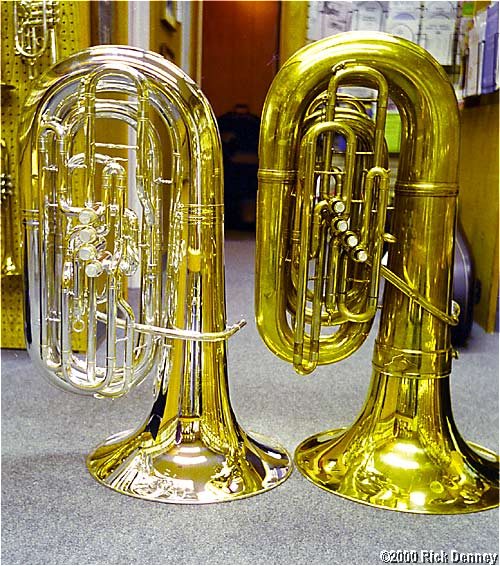
VMI 3301 BBb tuba. I have commented on various forums that I thought this tuba was a bit smaller than my York Master, but it is always called a 4/4 tuba. My impression of the sound differences with the York seem to follow the difference in size apparent in this photo--despite being an excellent instrument didn't have the depth of sound of the York Master.
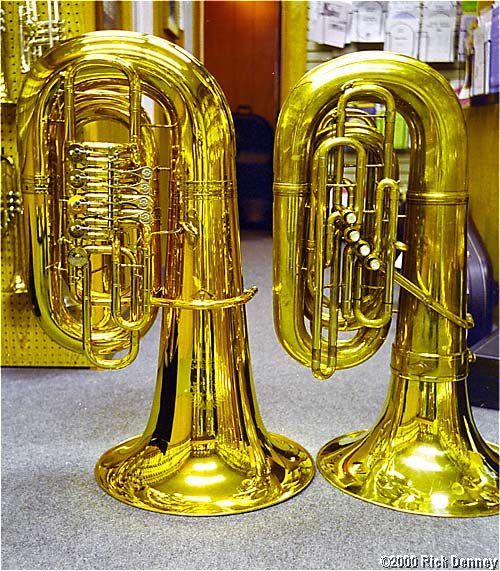
VMI Culbertson Neptune 6/4 CC tuba. Notice how much larger are the Neptune's bottom bow and bell throat. This is a BAT in the rotary style, where everything is big from bell to bore, including the overall height. I had difficulties with this instrument--it is clearly bigger than my limited abilities would support during my Dillons visit. But since playing the Holton, my air power has improved and the rotary Neptunes seem a lot easier to blow now.
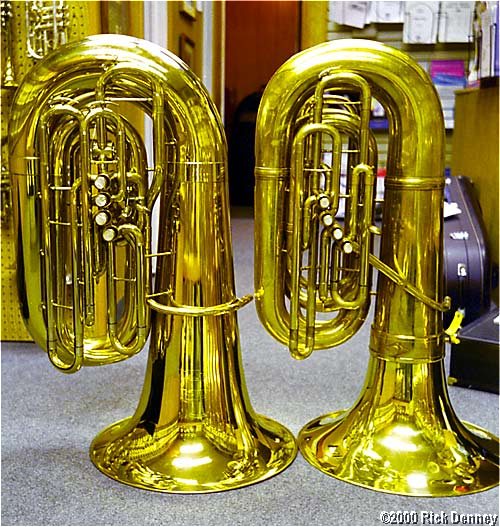
Meinl-Weston 2165 CC tuba. The 2165 was designed in cooperation with Warren Deck of the New York Philharmonic, and apparently based on a Holton design from the 50's that was loosely based on the Chicago York. (The Holton is similar to the silver instrument on my "Cutting an Eb to an F" article, and also to the the Holton pictured further down). This instrument is a 6/4, and again the large bottom bow and bell throat are the basis for this designation. The 2165 has been replaced with the 2265, and now the Alan Baer handmade version, but they are all in the same size class.
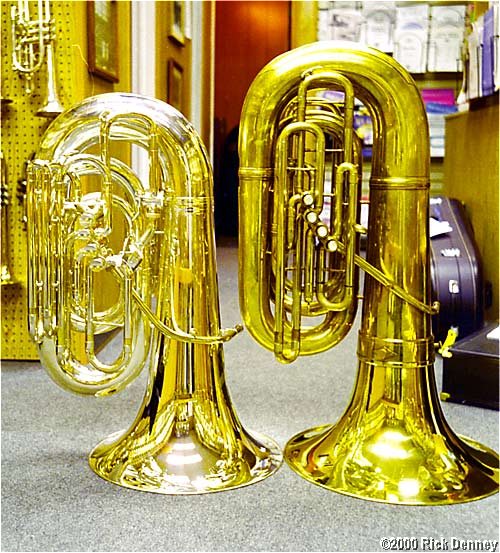
Conn 52J CC tuba. One of the most popular new tubas on the market, the Conn 52J is built from parts made for the King 2341 BBb tuba with a bell from an older King Eb tuba. The Conn is listed as a 4/4 instrument, but the York Master dwarfs it in physical size. Size isn't everything, however, and the Conn is known for producing a sound out of proportion to its apparent size. Based on the description of this tuba as a 4/4, however, I'd decided that my York Master must be a 5/4.
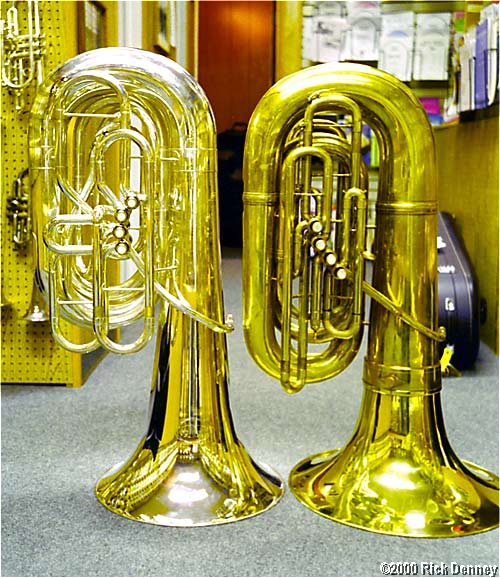
Jupiter 582 BBb tuba. This low-cost instrument has been popular with many schools and students, both because of its price and its playing characteristics. I like the instrument a lot. It is a solid 4/4 instrument, despite the smaller bell, and despite the fact that it is clearly smaller than the York Master.

Dillon/Conn Converted CC tuba. Matt Walters created this instrument from parts of an old 4/4 BBb Conn tuba.
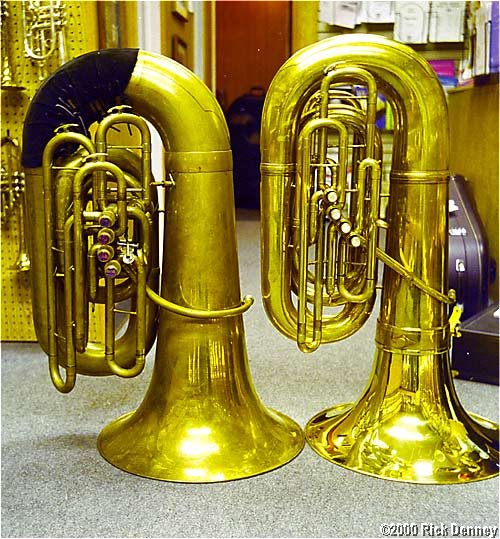
Holton 345 Dillon-converted CC tuba. The Holton is a classic American BAT that is even larger than the York from which it is reportedly derived. I thought this instrument played pretty well, but not as good as that lovely converted York at the top of this article, and not as good as my own Holton 345 (shown further down).

Holton Factory CC compared with Boehm and Meinl/Rusk CC conversion. This photo was supplied by Dale Phelps, who owns both instruments pictured. I put it here for a couple of reasons. The first is that it lets you compare a Holton CC conversion with the factory-produced Holton CC tuba. It also lets you compare a Boehm and Meinl tuba that was converted to CC by Rusk with my Boehm and Meinl-made York Master. They aren't exactly the same. Dale's B&M uses a one-piece bell of somewhat larger throat than my York Master, but the other outer branches appear almost identical, in comparision with the Holton. The difference in throat is exaggerated by the lower camera angle in the photo at right. Dale's Holton is 39 inches tall--the same as my York master, and all the tubas have approximately the same bell diameter within an inch or so. The converted Holton, and the converted B&M, are about an inch shorter, probably as a result of the conversion.
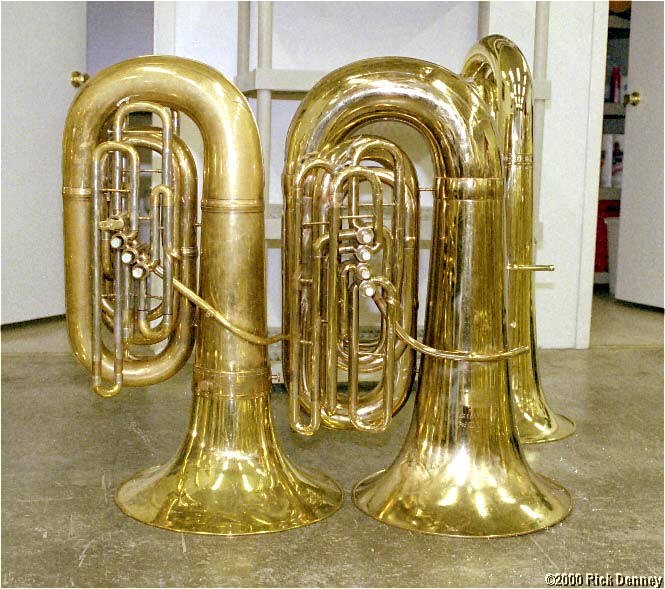
Holton BB-345. This is my own Holton that is in its original key of BBb, shown at Baltimore Brass on the day I bought it. The York Master is at left in this picture.
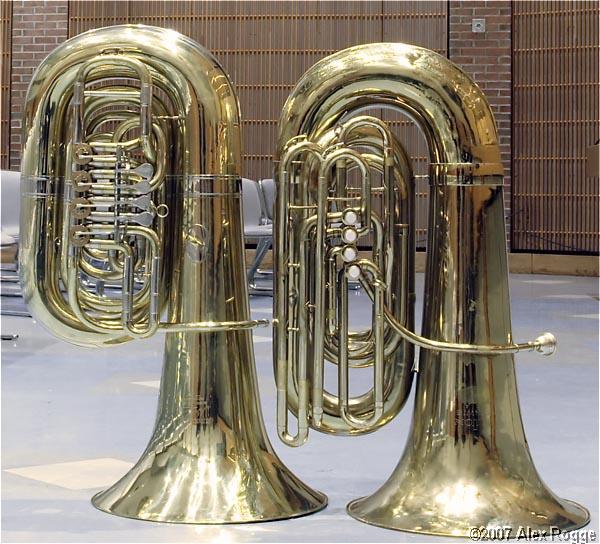
Rudolf Meinl 5/4 CC. This Rudy is now owned by Ray Grim, compared with my 6/4 Holton BB-345. Most believe that the 5/4 Rudy is a 6/4 in anybody's book, and this picture doesn't disprove it. The bell throat may be a touch fatter on the Holton. Rudy has a 6/4, too. I've seen and played one that is now owned by Mike Lynch. It is a truly awesome instrument that dwarfs any of the behemoths shown on this page. You could roll quarters through the valve branches, but it is surprisingly easy to play. The 5/4 Rudy pictured here is also a pleasure to play. I am grateful to Alex Rogge, a professional event photographer, who made the picture for me at the 2007 U.S. Army Band Tuba Euphonium Conference, and then gave me permission to publish it here.
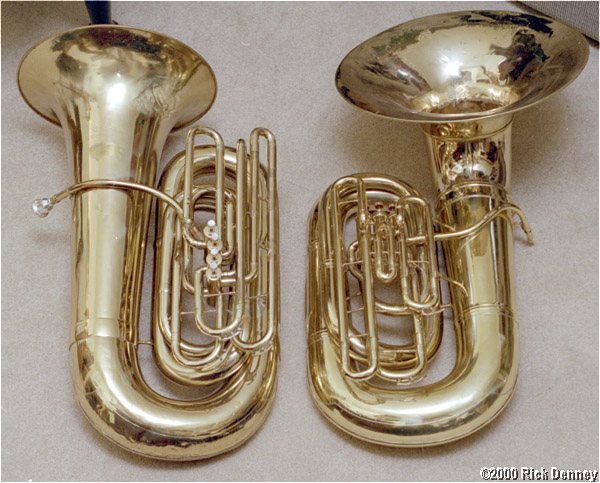
Conn 20J. These are big tubas that use the same basic outer branches as most all the Conn 2xJ and 3xJ-series tubas. These tubas may have top-action or front-action valves, and may have fixed or removable bells. But they are all big. Some have called them 5/4 instruments, or have stated they are smaller than the classic BAT such as the Holton BB-345 that is on the left, but I can't see the difference. The Holton is the same instrument shown above.
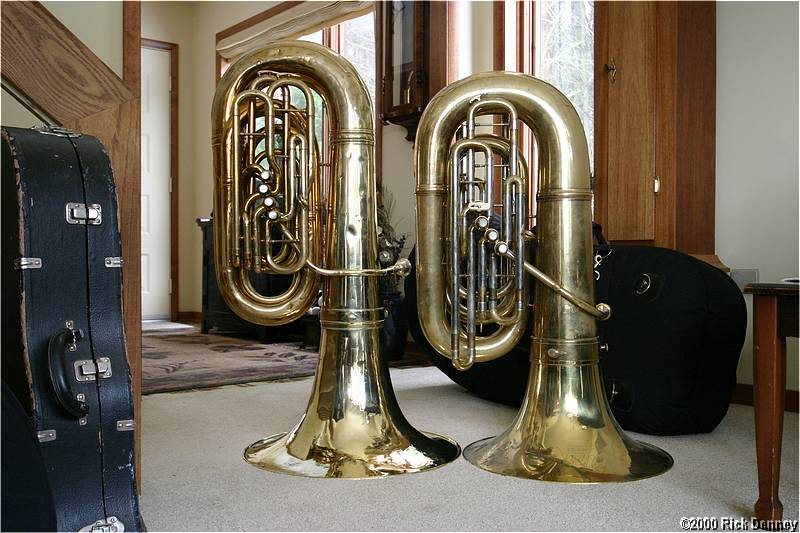
King 1241. This is the older style of the detachable-bell 2341 model, with upright bell. The 1241 has the double loop in the upper branch of the third valve, and the top bow of the first-valve branch is fixed rather than being movable as with the 2341. The 1241's also had a 22" bell, while many of the 2341's had 20" bells. The forward bells were 24". The valve body is basically the same as the current fixed-bell 2341, but the new model has the bottom bow and bell stack from an old Monster Eb Bass, as with the similar Conn 52J (see above). The Kings are BBb instruments. As you can see, the old detachable-bell 1241 and 2341's were tall instruments--41" at least. But they are not really fat instruments, and they fall squarely into the 4/4 category.
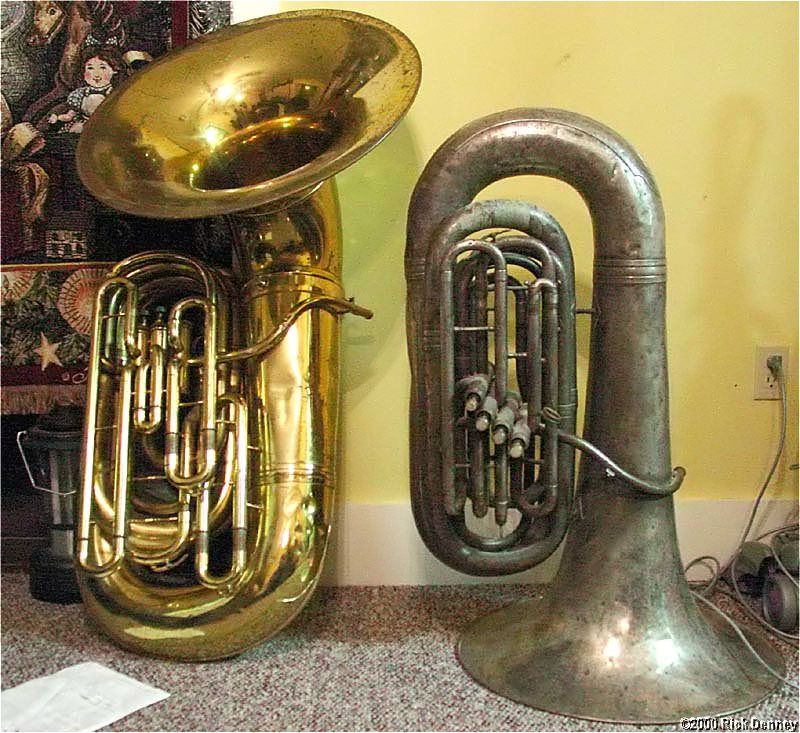
Old King. I don't really know what model of old King this instrument happens to be, but it appears to be a forerunner of the 1241 with a fixed bell. It's shown here next to a 6/4 Conn 24J for comparison (the 24J is similar to the 20J shown above).
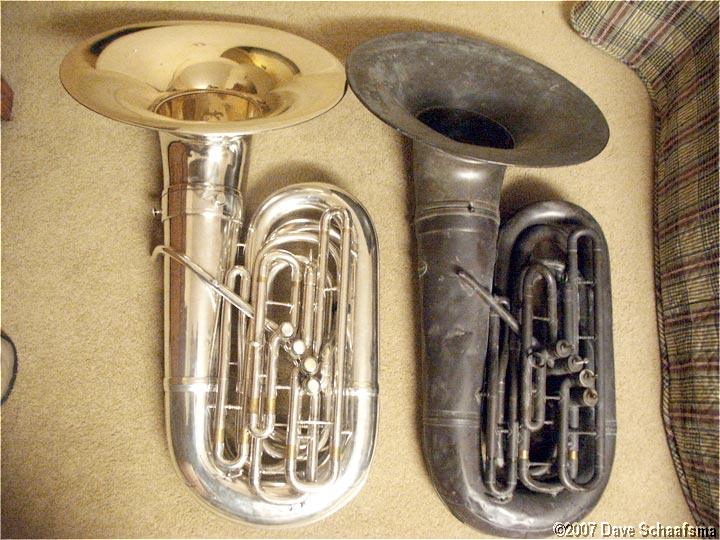
York Model 716. Dave Schaasfma thought he was buying a Blessing, but it turned out to be a York Model 716 labelled as a Blessing. It's the instrument on the right, in the queue for restoration. The one on the left is a beautifully maintained York Master, as made by Boehm and Meinl, and quite similar to my own. His York Master is older (1955), and closer to the original York model.
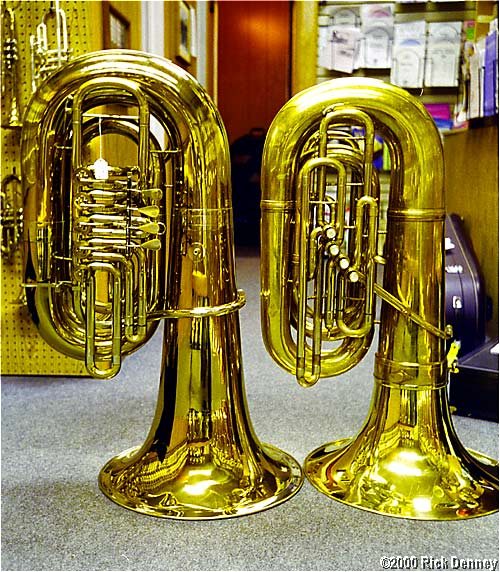
Cerveny ACB-601-5MR CC tuba. The big Cerveny is ostensibly a 5/4 instrument, but most players rank it in the 6/4 class, and you can see why.
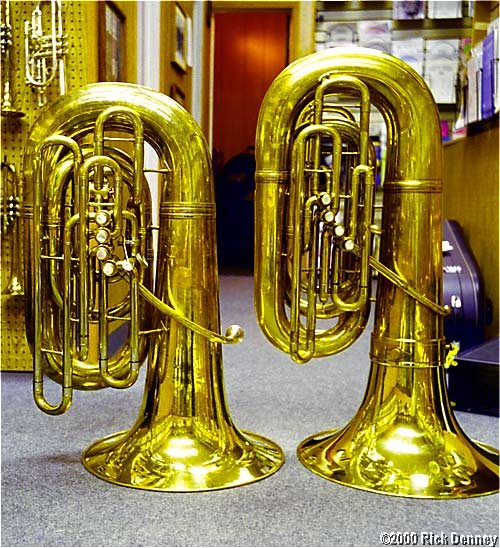
Dillon/Beuscher/Nirschl converted CC tuba. This is another Matt Walters creation, and one of the warmest and most mellow-sounding tubas I've ever played. Breathe into it and it sings. It's made from a Beuscher bell, a Nirschl bottom bow, and either a Nirschl or Meinl-Weston valve body (I forget which). My York Master was made by Boehm and Meinl, which is now owned by Walter Nirschl, and the two bottom bows seem identical between these instruments. The Beuscher bell sounds so nice on this horn that I've considered finding one and having it fitted on my York Master. Dillon Music calls this horn a 5/4, and it does fall in between, say, a 52J and a Holton.